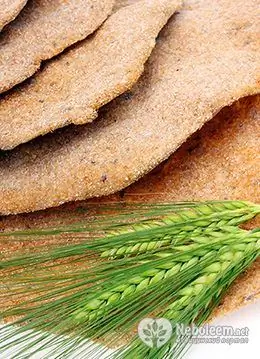- Author Rachel Wainwright [email protected].
- Public 2023-12-15 07:39.
- Last modified 2025-11-02 20:14.
Calorie content of white bread
Bread is one of the foods with a sufficiently high nutritional and energy value, which makes it essential in the diet of both children and adults. Since the days of Rome and Ancient Greece, the recipe for making bread, as well as its role in the human nutritional diet, has remained practically unchanged.
The benefits and harms of white bread

In addition to the fact that the bread contains complex carbohydrates, which are a source of energy, and a certain amount of protein, it contains: fiber, vitamins (most of all - folic acid and B vitamins involved in the work of nerve cells), micro- and macroelements (magnesium, zinc, calcium).
Any baked goods made from wheat flour are classified as white bread. In this case, flour of various types and varieties can be used, which determines the number of calories in white bread.
In terms of the number of useful properties, bread, of course, belongs to useful and necessary products in the diet. Despite the relatively high calorie content, white bread is recommended to be eaten daily due to the significant amount of carbohydrates and essential vitamins.
Usually, wheat flour and water are used to make bread. Culinary yeast is also a necessary ingredient for its preparation. However, the modern food industry often uses various food additives during the preparation of bread to enhance the flavor and extend the shelf life. That is why many doctors and nutritionists recommend preparing bread on your own in order to eliminate the effect of these substances on the body.
How many calories are in white bread
The average calorie content of white bread is 240-260 kcal. However, the exact number of calories in white bread depends on the recipe for making the bread, since all the ingredients in it affect the final calorie content of the product.
Many nutritionists believe that bread, regardless of its calorie content, should not be excluded from the diet of those who seek to lose weight. However, they note that in this case one should eat bread made from a mixture of wheat flour and bran. In this case, the calories in white bread are about the same (245 kcal), however, due to the increase in the amount of fiber, it is absorbed faster and more completely. To reduce the calorie content of white bread, in addition to wheat flour, you can use rye flour. This will reduce the calorie content to 217-220 kcal per 100 g of bread.
How many calories are in white bread depends on the type of baked product. At the same time, the calorie content of buns, braids and other sweet bakery products made from wheat flour is significantly higher than the calorie content of white bread. So, 100 g contains:
- In a baguette - 282 kcal (7.9 g of proteins, 1.7 g of fat, 60.1 g of carbohydrates);
- In ordinary wheat bread - 245 kcal (5.4 g of proteins, 1.3 g of fat, 57 g of carbohydrates);
- In a bun with jam - 293 kcal (6.5 g of proteins, 4.2 g of fat, 57.1 g of carbohydrates);
- In a cheesecake with cottage cheese - 318 kcal (10.6 g of proteins, 12.3 g of fat, 40.1 g of carbohydrates);
- In a bun with poppy seeds - 304 kcal (7.5 g of proteins, 5.2 g of fat, 55.5 g of carbohydrates);
- In the wicker - 333 kcal (7 g of proteins, 7 g of fat, 61.6 g of carbohydrates);
- In a pie with jam - 284 kcal (5.3 g of proteins, 61 g of fat, 2.1 g of carbohydrates);
- In a sweet bun - 299 kcal (8 g of proteins, 5.3 g of fat, 53.7 g of carbohydrates);
- In a wheat bun - 272 kcal (7.3 g of protein, 1.5 g of fat, 58.5 g of carbohydrates).
Calories in White Bread, Based on Additional Ingredients

In order to use white bread as part of a healthy diet, nutritionists recommend not buying ready-made products, but preparing it yourself. At the same time, in order to improve the taste, aroma, vitamin and mineral composition, as well as change the caloric content of white bread, it is recommended to add seeds of various oil plants, nuts, spices and spices to its composition:
- Anise is a spice native to the Mediterranean of the umbrella family, which gives bread a rather rich sweetish-tart flavor. Anise is traditionally used in bread baking in Austria, southern Germany and some other European countries. Anise does not reduce the calorie content of white bread, but contributes to its better absorption and reduction of flatulence;
- Fennel is a popular bread condiment in many European countries. It has similar aroma and properties to anise;
- Coriander with a slightly sweet taste is used not only for sweet pastries, but also for baking ordinary bread. This seasoning is most popular in Germany;
- Cumin is infused with essential oils to give breads and buns a rich, spicy flavor. Typically, cumin is added to baked goods with whole seeds in the dough, or sprinkled on top. Cumin also does not greatly affect the calorie content of white bread, however, it is considered one of the best spices for flatulence;
- Pumpkin seeds can be added to bread either whole or chopped. Thanks to linolenic acid, one of the unsaturated fatty acids necessary for the body, pumpkin seeds significantly improve the nutritional value of bread and improve its digestibility, although they slightly increase the calorie content of white bread;
- Flax seeds saturate bread with both nutrients and ballast substances, which help to improve digestion and prevent constipation. Flax is a source of vitamins, complete vegetable protein, fiber and essential trace elements. Also, bread made with flax seeds helps to lower cholesterol levels;
- Poppy seeds are most often used in the preparation of sweet products. However, poppy seeds can also be added to ordinary white bread, which will improve its nutritional and vitamin composition, will help improve digestion, although it may slightly increase the calorie content of white bread;
- Sesame seeds are added both to the dough and sprinkled on top to give the bread a nutty flavor. Sesame seeds are high in calories, but they also contain large amounts of calcium, magnesium and iron;
- Sunflower seeds are used in a wide variety of bread recipes. In addition to improving taste, seeds also make baked goods crispy, enriching them with many microelements, most of which are magnesium;
- Walnuts are most often added to bread coarsely chopped, which gives the product a special aroma and nutty flavor. Nuts are also rich in unsaturated fatty acids and vitamin E. Despite the fact that nuts increase the calorie content of white bread, such bread is considered more healthy and better absorbed;
- Cinnamon is a tropical spice with a slightly bitter taste and spicy scent that is sold as bark pieces or ground. Typically, cinnamon is added to biscuits, gingerbread cookies, buns, and braids. However, it can be added in small amounts to bread to improve taste and aroma, and it is also believed that this spice has a beneficial effect on digestion and aids in weight loss;
- Cloves are high in essential oils. It is most often added to gingerbread dough, but due to its strong spicy aroma and pungent taste, it can also be used in baking bread to improve its absorption.
Found a mistake in the text? Select it and press Ctrl + Enter.






